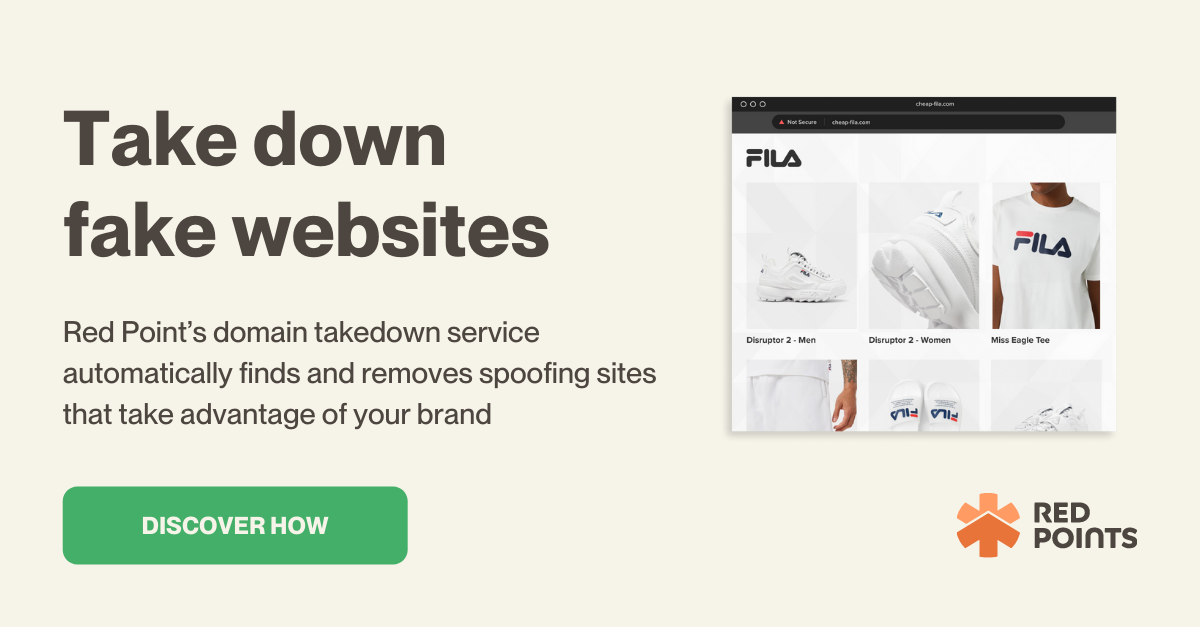Brand impersonation attacks are easy to build and easier to execute, even for unsophisticated hackers. In most cases, bad actors will duplicate a website or send out fake emails from seemingly legitimate-looking domains.
So how do you make sure to prevent business impersonation attacks in order to protect your brand reputation and brand integrity?
In this article, we discuss:
- What is a business impersonation attack?
- What are the types of business impersonation attacks?
- The top ways to prevent business impersonation attack
- How Red Points can help effectively stop and prevent impersonation attacks

What is a business impersonation attack?
A business impersonation attack happens when an attacker or a bad actor poses as a trusted person to steal sensitive information from a company or its customers.
The goal of these bad actors can be multifaceted including getting money transferred to a fraudulent account, hacking into the company’s network, or accessing sensitive company data.
These types of attacks mostly happen through fake websites, social media platforms, and even emails.
Here are a few ways business impersonation attacks can happen:
- Attackers can impersonate the CEO or a high-level executive of the company to convince a new or low-level employee to follow their instructions without any doubt in order to get access to sensitive data
- Attackers can impersonate popular brands and reach out to customers to steal their personal information and credit card details
- Attackers can even pretend to be third-party vendors or suppliers to trick company employees into paying fake overdue invoices
Types of business impersonation attack
Email spoofing: In email spoofing, attackers create fake email addresses that look very similar to the ones that they want to impersonate to confuse people. For instance, attackers may change a single character in the email address and alter the display name to make it seem like the email is from a legitimate source.
Account takeover: Attackers can also hack accounts and get the login credentials of the company’s CEO or other top-level executives. Then they can use the compromised legitimate account to impersonate the CEO or executives and gain access to sensitive information by emailing other employees directly.
Fake social media accounts: Bad actors can create fake impersonation business social media accounts of businesses or their employees by copying all the data from the original account. They can then reach out to customers or other employees to steal their data, and even money.
Fake websites: A website impersonation attack, also known as domain impersonation or website cloning, occurs when a hacker or cybercriminal creates a forged version of your company website to lure customers and trick them into making purchases.
5 ways to prevent business impersonation attack
1- Employee training
Over 95 percent of security breaches occur due to human error. By training your employees effectively, you can also prevent the majority of business impersonation attacks from ever occurring.
You should establish a dedicated cybersecurity manual and routine seminars to inform employees about safety best practices that they should follow. This can include tips about regularly changing account passwords and never signing in from public devices.
Employees should also be encouraged to verify the identity of senders if they are asked for any kind of sensitive information out of the blue over email. At the same time, employees should be urged to contact the tech team immediately if they think their account or a colleague’s account has been compromised.
2- Consumer education
It is also just as important to educate your customers about your brand to ensure they don’t fall prey to any business impersonation attacks. Share your official social media accounts and website link with customers in all of your direct communications. You should also remind your customers that you will never ask for their personal details or credit card information.
3- Safeguard your company domain
Infringing a website is one of the easiest and most popular ways to impersonate a business. If you don’t take any active steps against domain spoofing, bad actors can fool your customers by building a fake online store in your business’s name and chipping away from your sales.
To protect your domain and prevent spoofing and possible business impersonation, adopt a domain management tool that can automatically detect registered domains similar to yours across multiple platforms and recover them.
4- Actively monitor on social media platforms
Monitor social media platforms regularly to prevent social media impersonation. You should also monitor branded keyboards and other broad keyboards related to your business including misspelling and alphanumeric combinations to ensure no one is using your brand name to tarnish your reputation or trick your customers.
5- Monitor app stores
Fake mobile apps can be designed to look like legitimate apps and even advertised by bad actors to confuse your customers. The consequences of these mobile apps can be drastic including damage to your reputation, loss of revenue, and decreased customer loyalty.
To stop business impersonation attacks and protect your intellectual property, you need to constantly look out for duplicate apps across different marketplaces like Apple’s App Store and Google’s Playstore.
What’s next
Brand impersonation attacks have become a rather growing problem for businesses around the world. The risks include loss of revenue, brand trust, and even customer loyalty. As a result, businesses need to take proactive steps to approach this problem and remove any kind of infringements as soon as they see them.
Red Point’s Impersonation Removal solution can effectively prevent, detect and stop all kinds of business impersonation attacks and in turn, help protect your brand reputation.
See how you can automatically find and remove fake accounts, apps, sites, and domains, to protect your customers and reputation with Red Points.






